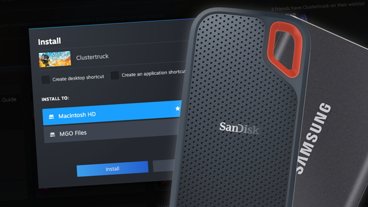Google has confirmed the existence of an issue in a Chrome update that has reportedly affected movie studios that use the Avid video editing suite on the cylindrical Mac Pro, with the company offering a solution to the issue it claims will recover affected machines.
Reports on Monday surfaced claiming video editors in Los Angeles were discovering their Mac Pro workstations were refusing to boot or would "slowly crash" during use. While initial reports proposed the issue was malware or a virus affecting Avid Media Composer version 8.8 or later on a 6.1 Mac Pro running a version of macOS prior to High Sierra, investigations led to the issue with the Chrome update.
After publishing a list of commands for Terminal to fix the problem late on Tuesday, Google Support has since produced a support page explaining both the error and a more refined Terminal command list.
According to Google Support, the issue was a Chrome update that had a "bug that damages the file system on macOS machines with System Integrity Protection (SIP) disabled," as well as machines that do not support SIP. Google has paused the release of the Chrome update while a new update can be finalized without the bug.
Users who have not taken steps to disable SIP, and are running OS X 10.9 cannot be affected by the issue at all. The videographers had a higher rate of incidence for the problem, because to enable hacks for external GPUs to work on Thunderbolt 2 chains, SIP has to be disabled.
The recovery process for affected Macs requires users to boot into recovery mode, then to go to the Utilities menu and open the Terminal application. Assuming an afflicted computer's boot drive is called "Macintosh HD" Google recommends running the following list of commands in Terminal, then rebooting.
chroot /Volumes/Macintosh\ HDrm -rf /Library/Google/GoogleSoftwareUpdate/GoogleSoftwareUpdate.bundle
mv var var_back
ln -sh private/var var
chflags -h restricted /var
chflags -h hidden /var
xattr -sw com.apple.rootless "" /var
Google has amplifying information in regards to the Terminal commands on the support page.
The command list is very similar to the previously published advice, with the goal of creating a symlink fix while enabling the removal of Keystone's LaunchAgents, but with the addition of a line to turn the existing var folder into a backup.
 Malcolm Owen
Malcolm Owen







-m.jpg)






 Amber Neely
Amber Neely
 Andrew O'Hara
Andrew O'Hara
 Mike Wuerthele
Mike Wuerthele
 William Gallagher
William Gallagher

 Christine McKee
Christine McKee







56 Comments
The internet is pretty wonderful in its ability to disseminate useful information, obscure or not.
I was re-imaging a 2007 & 2008 iMac that I put little SSDs in (still beautiful, basic internet terminal). I replaced the little button-cell battery on both, but only one lost the date (which I didn't know).
Upon trying to load the O/S, it said something about not finding "valid packages", even though I had done the same process as on the first one.
Total "wtf" right?
I re-imaged my little USB-2.0 thumb drive with the O/S to re-copy the "packages", but no luck.
Internet search found a forum entry: "Oh yeah, it lost the date, open terminal and type this command in this format...."
Done.
I barely remember my first-PC life with my 1989-era Austin 286 PC, 16Mhz, 40MB Hard drive, where a game wouldn't work unless you manually set IRQ and DMA channels.
Sometimes waiting on a phone for 40 minutes for tech-support, or talking to "that guy at work" that just knew everything...
E.
PS: I still have the little 0.75"-square chip from that 286, (it's from AMD),
It's in a desk drawer with my sD cards, thumb-drives, and old RAM sticks.
Why would anyone on a Mac ditch Safari for Chrome is beyond me. This piece o garbage is a resource hog on par with some scientific computing programs I’m running.
Safari is one of the high points in my choosing of Apple hardware. But to each their own, dumb as it may appear...
Not at all an excuse, but there are two big reasons people in these environments use Chrome - Remote Desktop and the browser itself is actually built into several applications. Installing the browser system files will happen even if you do not actually install the actual browser. By installing the browser, you are actually keeping your system up to date (and closing security vulnerabilities).
The real issue here is disabling SIP. This happened for a LOT of video people because of eGPU and kexts with NVIDIA web drivers for a long time.
My 2 cents: Drag the Chrome App to a running version of AppCleaner so as to get all its bits and delete the lot.
So machines running the latest macOS with SIP were not affected by Google’s boo-boo? Maybe this security thing is actually worth some thing.
Mac Pros shipped with Mavericks, then came Yosemite. SIP didn’t arrive until El Capitan. I would think that studios would be little motivated to update the operating system if the one running is doing the job for them. So my guess is that many of the machines that crashed were still on earlier versions of macOS without SIP, not that SIP was intentionally disabled. But why only the trashcan pro? Many users have Chrome installed on older Macs and older versions of macOS.
This latest hiccup has shown that these big tech companies, while competitors, are also interdependent on each other for software and hardware. One screws up and it affects many levels and platforms. Apple centric tech blogs tend to focus on Apple related problems and tech blog comment sections are quick to blame and condemn Apple for everything that goes wrong. Not on this case it would seem.
[u] I take back the part about SIP. The article explains that videographers often use hacks to make their eGPUs work and disable SIP.